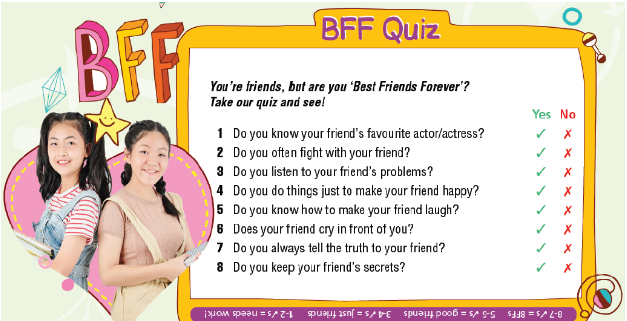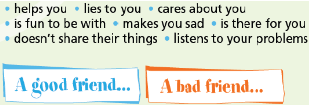Tiếng Anh 7 Unit 1 1. Right on!
1 Are you a good friend? Take the quiz to find out. 2 It’s International Friendship Day. Find a good quote and prepare a poster for the class. Use the key words friendship quotes. 3 What makes a good friend? Put the ideas in the list under the headings. Add two more of your own. 4 Use the ideas in Exercise 3 to prepare and give a presentation on how to be a good friend. 5 “A friend in need is a friend indeed.” Discuss in groups.
Project Time 1 (Dự án thời gian 1)
Bài 1
1. Are you a good friend? Take the quiz to find out.
(Bạn có phải là người bạn tốt? Giải câu đố để tìm ra đáp án.)

Phương pháp giải:
1. Do you know your friend’s favourite actor/actress?
(Bạn có biết diễn viên nam / diễn viên nữ yêu thích của bạn mình không?)
2. Do you often fight with your friend?
(Bạn có thường xuyên gây gổ với bạn của mình không?)
3. Do you listen to your friend’s problems?
(Bạn có lắng nghe những vấn đề của bạn mình không?)
4. Do you do things just to make your friend happy?
(Bạn có làm những việc chỉ để bạn của bạn vui không?)
5. Do you know how to make your friend laugh?
(Bạn có biết cách làm cho bạn của bạn cười không?)
6. Does your friend cry in front of you?
(Bạn của bạn có khóc trước mặt bạn không?)
7. Do you always tell the truth to your friend?
(Bạn có luôn nói sự thật với bạn mình không?)
8. Do you keep your friend’s secrets?
(Bạn có giữ kín bí mật của bạn mình không?)
Bài 2
2. It’s International Friendship Day. Find a good quote and prepare a poster for the class. Use the key words friendship quotes.
(Đó là Ngày Tình bạn Quốc tế. Tìm một câu trích dẫn hay và chuẩn bị một áp phích cho lớp học. Sử dụng các từ khóa trích dẫn tình bạn.)
Lời giải chi tiết:
1. I would rather walk with a friend in the dark, than alone in the light.
(Tôi muốn đi bộ với một người bạn trong bóng tối, còn hơn một mình trong ánh sáng.)
2.A good friend knows all your stories. A best friend helped you create them.
(Một người bạn tốt biết tất cả những câu chuyện của bạn. Một người bạn tốt nhất đã giúp bạn tạo ra chúng.)
3.True friends are like diamonds—bright, beautiful, valuable, and always in style.
(Những người bạn chân chính giống như những viên kim cương - sáng, đẹp, có giá trị và luôn phong cách.)
Bài 3
3. What makes a good friend? Put the ideas in the list under the headings. Add two more of your own.
(Điều làm nên người bạn tốt? Đặt các ý tưởng trong danh sách dưới tiêu đề. Thêm hai cái nữa của riêng bạn.)

Lời giải chi tiết:
|
A good friend |
A bad friend |
|
Helps you (Giúp đỡ bạn) |
Lies to you (Nói dối bạn) |
|
Cares about you (Quan tâm đến bạn) |
Makes you sad (Làm bạn buồn) |
|
Is fun to be with (Rất vui khi ở bên bạn) |
Doesn’t share their things (Không chia sẻ nhiều thứ của họ) |
|
Is there for you (Dành thời gian cho bạn) |
|
|
Listens to your problems (Lắng nghe những vấn đề của bạn) |
Add my owns:
+ A good friend: hang out with me (đi chơi với tôi), study with me (học bài cùng tôi),…
+ A bad friend: take advantage of me (lợi dụng tôi), slander me (vu khống tôi), …
Bài 4
Presentation Skills (Những kỹ năng thuyết trình)
4. Use the ideas in Exercise 3 to prepare and give a presentation on how to be a good friend.
(Sử dụng các ý tưởng trong Bài tập 3 để chuẩn bị và thuyết trình về cách trở thành một người bạn tốt.)
Lời giải chi tiết:
Ralph Waldo Emerson said: “The only way to have a friend is to be one.” But the question is: How can someone be a good friend?
First of all, always be there for your friend. For example, if someone starts telling lies about them, speak up for your friend.
Next, always keep your promises. And of course, don’t share your friend’s secrets with others.
Last but not least, listen to your friend. When your friend is talking to you, pay attention to what they say. Listening to your friend shows you care about them.
To sum up, a good friend is always there for your friend, always keeps your promises, and listens to your friends.
Tạm dịch:
Ralph Waldo Emerson nói: "Cách duy nhất để có một người bạn là trở thành một người bạn." Nhưng câu hỏi đặt ra là: làm thế nào để ai đó có thể trở thành một người bạn tốt?
Trước hết, hãy luôn ở đó vì bạn của bạn. Ví dụ, nếu ai đó bắt đầu nói dối về họ, hãy lên tiếng bênh vực bạn của bạn.
Tiếp theo, hãy luôn giữ lời hứa của bạn. Và tất nhiên, đừng chia sẻ bí mật của bạn mình với người khác.
Cuối cùng nhưng không kém phần quan trọng, hãy lắng nghe người bạn của bạn. Khi bạn của bạn đang nói chuyện với bạn, hãy chú ý đến những gì họ nói. Lắng nghe bạn bè của bạn cho thấy bạn quan tâm đến họ.
Tóm lại, một người bạn tốt luôn ở bên bạn của bạn, luôn giữ lời hứa và lắng nghe bạn bè của bạn.
Bài 5
Value (Giá trị)
Friendship (Tình bạn)
5. “A friend in need is a friend indeed.” Discuss in groups.
(Một người bạn đang cần là một người bạn thực sự.” Thảo luận theo nhóm.)
Lời giải chi tiết:
A: “A friend in need is a friend indeed.” Well, what does it mean?
B: I think it means that when you have problems and a friend helps you. This shows he/she is a good friend.
C: I agree. A good friend needs to be there for his/her friend in both good and bad times.
D: You’re right. A true friend doesn’t go away when his/her friend is in trouble. He/She stays and helps his/her friend.
Tạm dịch:
A: “Một người bạn đang cần là một người bạn thực sự. ”Tốt, nó có nghĩa là gì?
B: Tôi nghĩ điều đó có nghĩa là khi bạn gặp khó khăn và một người bạn giúp bạn. Điều này cho thấy anh ấy / cô ấy là một người bạn tốt.
C: Tôi đồng ý. Một người bạn tốt cần phải ở bên cạnh bạn của anh ấy / cô ấy trong cả thời điểm tốt và xấu.
D: Bạn đúng. Một người bạn thực sự không ra đi khi bạn của anh ấy / cô ấy gặp khó khăn. Anh ấy / cô ấy ở lại và giúp đỡ bạn của anh ấy / cô ấy.












